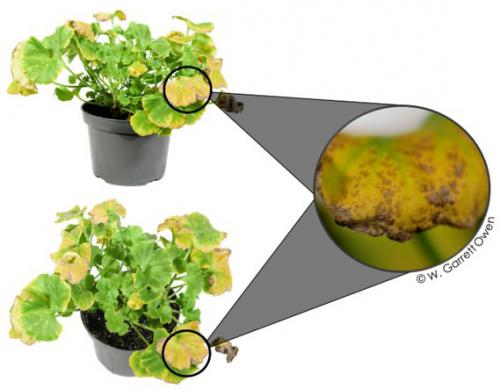Low substrate pH causes lower leaf chlorosis and necrosis in geraniums
Geraniums grown in substrates below the optimal pH range of 5.8 to 6.4 will exhibit chlorotic leaf spotting between veins, interveinal chlorosis, and marginal and leaf necrosis of the lower foliage.

During zonal geranium (Pelargonium × hortorum) production, growers should monitor and adjust (raise or lower) substrate pH to the optimal range of 5.8 to 6.5. During the first month of geranium production, little pH adjust is often required. However, as plants mature, water and fertility demand increases, leaching occurs, substrate pH drop can occur. When substrate pH drops below 5.8, iron (Fe) and manganese (Mn) availability and uptake increases. Plants accumulate these immobile nutrients to toxic concentrations in lower leaf tissue, which we often refer to as Fe and Mn toxicity.
Symptoms of Fe and Mn toxicity begins in the lower leaves where they initially become chlorotic (yellow). See Figure 1.
Initial symptoms intensify and leaves exhibit chlorotic spotting, interveinal chlorosis, leaf bronzing, dark brown to black spotting along leaf margins, and marginal leaf necrosis (tissue death). See Figure 2.

Figure 2. Symptoms of low substrate pH induced iron (Fe) and manganese (Mn) toxicity in zonal geranium (Pelargonium × hortorum) includes chlorotic (yellowing) spotting, interveinal chlorosis, leaf bronzing, dark brown to black spotting along leaf margins, and marginal leaf necrosis (tissue death). Symptoms begin on the older, lower leaves and over time progress up the plant. Photo: W. Garrett Owen.
Necrosis often progresses inward between veins, and leaves become scaberous (rough) due to tissue death. Leaf drop often occurs and growers must remove leaves from plants prior to shipping.
To prevent substrate pH drop and thus, Fe/Mn toxicity, growers should monitor geranium nutrition. Michigan State University Extension recommends that growers determine substrate pH and soluble salts [referred to as electrical conductivity (EC)] by easily performing in-house 1:2 Dilution, Saturated Media Extraction (SME), or PourThru procedures. Each method will determine substrate pH similarly, however EC values vary with each method. For more information, refer to “Nutritional Monitoring: Geraniums.” Also, be sure that your pH and EC meter is working correctly and calibrated regularly. For a “how to video,” watch “How to Calibrate a pH and EC Meter.”
Corrective procedures for low substrate pH for geraniums should begin within the range of 5.4 to 5.6. To quickly adjust (raise) substrate pH to the optimal pH range, growers can perform any one of the procedure listed in Table 1. For additional low or high pH or EC corrective procedures, refer to “Corrective procedures for high and low substrate pH and electrical conductivity.”
|
Table 1. Corrective procedures1 to adjust (raise) low substrate pH during greenhouse production of geraniums (Pelargonium × hortorum). | ||
|---|---|---|
|
Flowable lime |
Hydrated lime |
Potassium bicarbonate (KHCO3) |
|
1. Apply 1 to 2 qt. per 100 gal. of water. 2. Rinse foliage after application. 3. Avoid damage to your injector by using rates of 2 qt. per 100 gal. of water, or less. 4. Split applications if needed. |
1. Mix 1 lb. in 3 to 5 gal. of WARM water. 2. Mix twice. 3. Let settle. 4. Decant liquid and apply through injector at 1:15. 5. Caustic (rinse foliage ASAP and avoid skin contact) |
1. Use 2 lbs. per 100 gal. of water. 2. Immediately, rinse foliage. 2. Provides 933 ppm potassium (K). 4. The following day, leach heavily with a complete fertilizer to reduce substrate EC and restore nutrient balance. 5. Rates greater than 2 lbs. per 100 gal. of water can cause phytotoxicity! |
|
1 Whipker et al. (2018) |
||
For more nutritional monitoring of greenhouse crops, read “e-GRO launches Nutritional Monitoring of Floriculture Crops website” and “In-house nutritional monitoring app provides optimal substrate pH and EC levels.”
The American Floral Endowment is gratefully acknowledge for funding to create fertdirtandsquirt.com and establish all available materials.
Literature cited
Whipker, B.E., J. Henry, and W.G. Owen. 2018. Corrective Procedures for Modifying Substrate pH and Electrical Conductivity (EC). e-GRO Alert 7(2):1–5.



 Print
Print Email
Email


